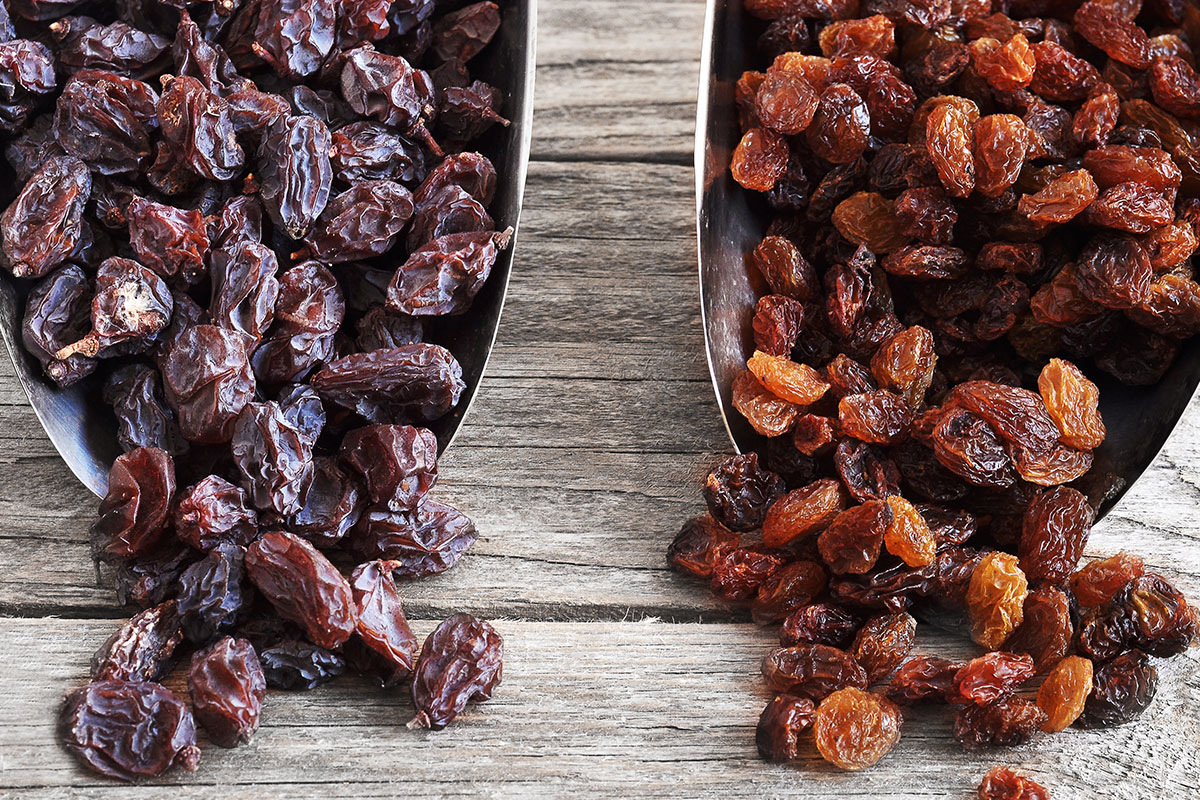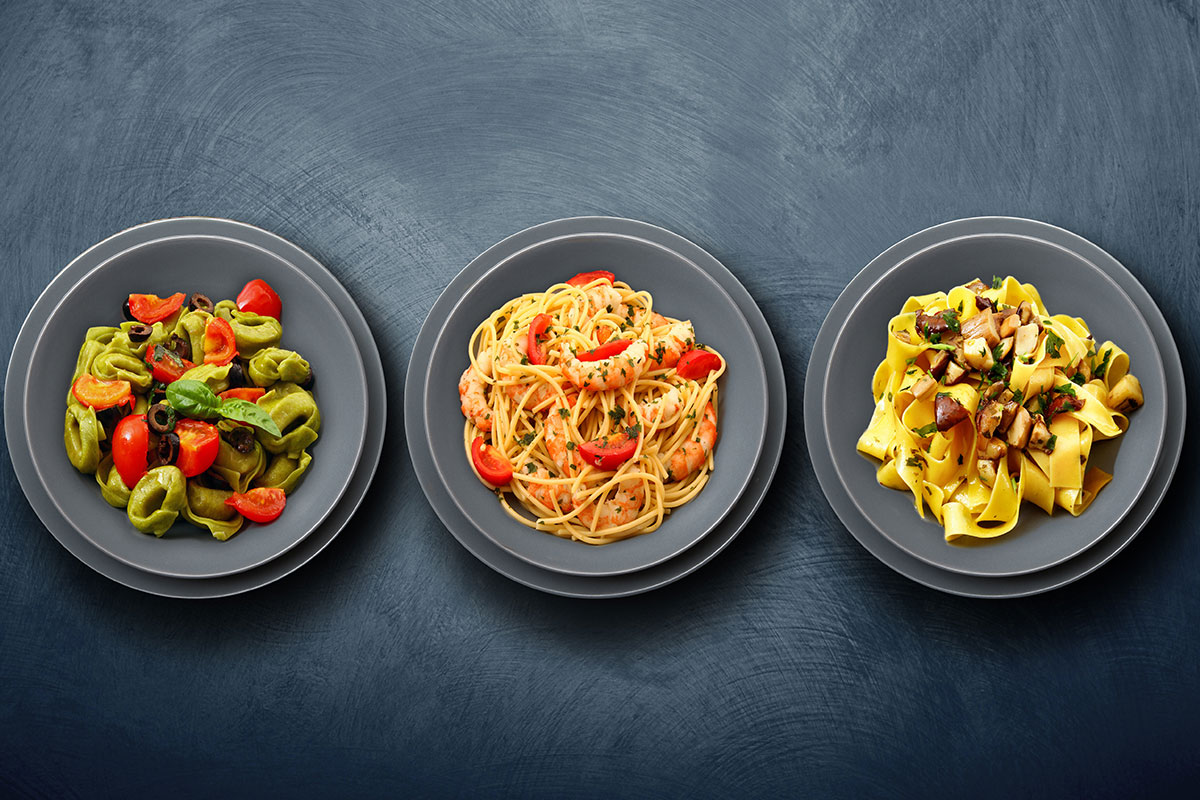Why am I Gaining Weight Despite Diet and Exercise? │ QA
If you’re careful with your nutrition, working out weekly, and still experiencing problems with your weight, take a moment to read this QA.


What are the good and bad points of sun-dried raisins?
– Anthony A.

Raisins are typically from Thompson Seedless Grapes in California that have been sun-dried (on vine or on paper trays), shade-dried or mechanically dehydrated. Regardless of the drying method, raisins usually undergo additional processing such as rinsing, stem removal and in the case of golden raisins, the addition of sulfur dioxide (to retain color). The benefit of sun-drying to a dark brown color is that the raisins are not chemically treated.
A ¼ Cup serving of raisins provide approximately 120 calories, 2 gm fiber, 310 mg potassium, 6% DV iron, 2% DV calcium, and antioxidants known as catechins. Depending on your perspective or weight goals, the energy density of raisins could be a good or bad point. Though they are more sugar-rich (by weight) than grapes, their vitamins and minerals are more concentrated, too. This is true of all dried fruits versus fresh.
Resources:
– Debbie J., MS, RD
This article should not replace any exercise program or restrictions, any dietary supplements or restrictions, or any other medical recommendations from your primary care physician. Before starting any exercise program or diet, make sure it is approved by your doctor.
Some questions have been edited for length and/or clarity.
 Have a nutrition question? Our registered dietitian is ready to help!
Have a nutrition question? Our registered dietitian is ready to help!
Email nutrition@lafitness.com or submit your question below and it may be featured in an upcoming article!
If you’re careful with your nutrition, working out weekly, and still experiencing problems with your weight, take a moment to read this QA.
Blood sugar control isn’t easy. These are Debbie’s top recommendations for how to address weight control with Type II Diabetes.
Does Intermittent Fasting give you enough time to pack the day's protein? Our registered dietitian helps clear up the confusion!


I don’t understand the different types of olive oil. There is robust, extra virgin, virgin, refined, etc. Is one better for cooking? What about using as a dip for bread? Can olive oil be used in cooking? I know olive oil is supposed to be better for you, but I fear I’m using the wrong types of this oil in my cooking!

Olive oil provides the same calories from fat that other oils do, though its cardiovascular health benefit is in the favorable ratio of unsaturated fats. Olive oil’s high ratio of monounsaturated fat is linked to reduced blood LDL cholesterol which is associated with a lower risk of heart disease.
The terms you mention have to do with the processing of olives into oil. There are over 50 olive varieties – thank the Greek gods that their oils are not kept separate or it would get really confusing! Here’s a rundown of what the different olives oils are and how best to use them:
At present, the USDA’s National Nutrient Database doesn’t differentiate between the various types of olive oil and provides nutritional information for a singular standard reference “olive oil.”
References:
– Debbie J., MS, RD
This article should not replace any exercise program or restrictions, any dietary supplements or restrictions, or any other medical recommendations from your primary care physician. Before starting any exercise program or diet, make sure it is approved by your doctor.
Some questions have been edited for length and/or clarity.
 Have a nutrition question? Our registered dietitian is ready to help!
Have a nutrition question? Our registered dietitian is ready to help!
Email nutrition@lafitness.com or submit your question below and it may be featured in an upcoming article!
If you’re careful with your nutrition, working out weekly, and still experiencing problems with your weight, take a moment to read this QA.
Blood sugar control isn’t easy. These are Debbie’s top recommendations for how to address weight control with Type II Diabetes.
Does Intermittent Fasting give you enough time to pack the day's protein? Our registered dietitian helps clear up the confusion!


I have a question about starchy carbs. I was reading an article online that said to eat starchy carbs (i.e. brown rice, sweet potatoes) only on days when I lift weights or do cardio. It said to avoid them on rest days and stick with veggies for carbs on those days. What’s your opinion on this?
– James B.

Thanks for asking my opinion, James. There is no nutritional minimum for starches as a source, only for the carbohydrates they contain (at least 130 grams daily*). So, if a person can meet his/her carbohydrate needs – which may still be quite high on rest days – I’m all for maximizing vegetables along with fruit and milk products for carbs. Although it would provide lots of micronutrients, consuming 300 grams of carbohydrate only from vegetables would probably overwhelm your gastrointestinal system.
Starch (complex carbohydrate) from grains, tubers, legumes and seeds, and products made from them (like pasta, cereals, bread and fries) provides a concentrated source of extended energy suitable for physical activity. Although I follow the logic to reduce carbs on non-workout days, there is no evidence that replacing starches intermittently will benefit your performance or physique. Besides, you’re still physically active outside the gym, right? If you’re completely sedentary in bed all day but not sick, then feel free to skip them on your off days.
* Institute of Medicine, Food and Nutrition Board. Dietary Reference Intakes: energy, carbohydrates, fiber, fat, fatty acids, cholesterol, protein, and amino acids. Washington: National Academies Press; 2002
– Debbie J., MS, RD
This article should not replace any exercise program or restrictions, any dietary supplements or restrictions, or any other medical recommendations from your primary care physician. Before starting any exercise program or diet, make sure it is approved by your doctor.
Some questions have been edited for length and/or clarity.
 Have a nutrition question? Our registered dietitian is ready to help!
Have a nutrition question? Our registered dietitian is ready to help!
Email nutrition@lafitness.com or submit your question below and it may be featured in an upcoming article!
If you’re careful with your nutrition, working out weekly, and still experiencing problems with your weight, take a moment to read this QA.
Blood sugar control isn’t easy. These are Debbie’s top recommendations for how to address weight control with Type II Diabetes.
Does Intermittent Fasting give you enough time to pack the day's protein? Our registered dietitian helps clear up the confusion!


Hi, I weigh 146 lbs. and have a small frame. I would like to put on muscle and get up to about 167 lbs. I am not a big eater and usually eat very small portions. I would like to know your recommendations for a diet.
– Sheldon S.

The situation you describe doesn’t leave a lot of room for options! I understand why you’ve reached out for advice. Increasing calories in a very limited volume can be quite challenging. Maximizing energy density can be done by 1) selecting rich foods, 2) through the addition of fats and sugars (Yep, you heard me say that correctly: fats and sugars), and by 3) power-packing.
1) Foods that are naturally energy-rich include nuts, nut butters, cheese, cream, oil, butter, dried fruit, nectars, traditional granola, tortillas, starchy vegetables, avocado, olives, coconut, bisque soups and chowders, salmon, beef liver, ice cream, and milkshakes. For packaged items, look for those that provide at least 300 calories per cup or 100 calories per ounce.
2) Anything that can be melted onto or into another food works! Ideas include cream in mashed potatoes, butter on noodles, pesto or avocado on sandwiches, cheese on casseroles, nut butter on toast, jam in yogurt, honey on fruit and mayonnaise on crackers. Nothing should be eaten plain if you are serious about gaining weight.
3) The concept of power-packing means to increase calories and protein without increasing volume. It involves replacing water content with higher calorie liquids. For example, fruit juice can be enriched by adding a cup of concentrate to each quart of liquid juice. For milk, add 2 Tbsp dry powdered milk to each cup fluid milk to gain 50 calories and 5 grams protein. Choosing oil-packed tuna over water-packed will give you over 100 calories more per 6 ounce can!
For meal and snack ideas, check out two sample weight gain menus from The University of Colorado, Colorado Springs.
Nutritional values obtained from the USDA’s National Nutrient Database for Standard Reference, Legacy Release. Findings were used along with RDN’s professional judgment.
– Debbie J., MS, RD
This article should not replace any exercise program or restrictions, any dietary supplements or restrictions, or any other medical recommendations from your primary care physician. Before starting any exercise program or diet, make sure it is approved by your doctor.
Some questions have been edited for length and/or clarity.
 Have a nutrition question? Our registered dietitian is ready to help!
Have a nutrition question? Our registered dietitian is ready to help!
Email nutrition@lafitness.com or submit your question below and it may be featured in an upcoming article!
If you’re careful with your nutrition, working out weekly, and still experiencing problems with your weight, take a moment to read this QA.
Blood sugar control isn’t easy. These are Debbie’s top recommendations for how to address weight control with Type II Diabetes.
Does Intermittent Fasting give you enough time to pack the day's protein? Our registered dietitian helps clear up the confusion!


I am at a healthy weight with good muscle mass (6 ft., 160 lbs., and ~11% body fat) for a 50-year-old male. What diet “dos” and “don’ts” do you have to reduce body fat to 10% or lower?
– Jerrod S.

Wow, Jerrod! Your 11% of body fat is already at a level that others aspire toward. Hard to say what will give you that final edge to reach sub 10% not knowing what you’ve done so far to get where you’re at. According to the makers of three major body composition analyzers*, less than 10% body fat for men aged 40-59 is “underfat”. The body needs a minimum amount of essential fat for cellular processes, an estimated 5% for men. At this point, too little fatty tissue impairs endocrine and metabolic functions.
Of course, by building muscle mass and increasing percentage of lean body mass, your percentage of fat will drop (without having to lose fat mass). Dedicated athletes, fitness models, and physique competitors reach low levels of body fat by different means. Regardless of goal or specific approach, they all take eating and exercise very seriously, to the point these two activities can make up the bulk of their waking hours. For whatever reason you want to see a “10%” on your next body composition assessment, you’ll have to be even more strict on the diet you follow now or reduce portions slightly. No magic bullet here – just more of the hard work you’ve already put in!
* Omron, Tanita, and InBody. Manufacturer’s websites accessed 3/25/2019.
– Debbie J., MS, RD
This article should not replace any exercise program or restrictions, any dietary supplements or restrictions, or any other medical recommendations from your primary care physician. Before starting any exercise program or diet, make sure it is approved by your doctor.
Some questions have been edited for length and/or clarity.
 Have a nutrition question? Our registered dietitian is ready to help!
Have a nutrition question? Our registered dietitian is ready to help!
Email nutrition@lafitness.com or submit your question below and it may be featured in an upcoming article!
If you’re careful with your nutrition, working out weekly, and still experiencing problems with your weight, take a moment to read this QA.
Blood sugar control isn’t easy. These are Debbie’s top recommendations for how to address weight control with Type II Diabetes.
Does Intermittent Fasting give you enough time to pack the day's protein? Our registered dietitian helps clear up the confusion!
Be the first to know about exclusive
content, deals and promotions